These swallows taught me some things.
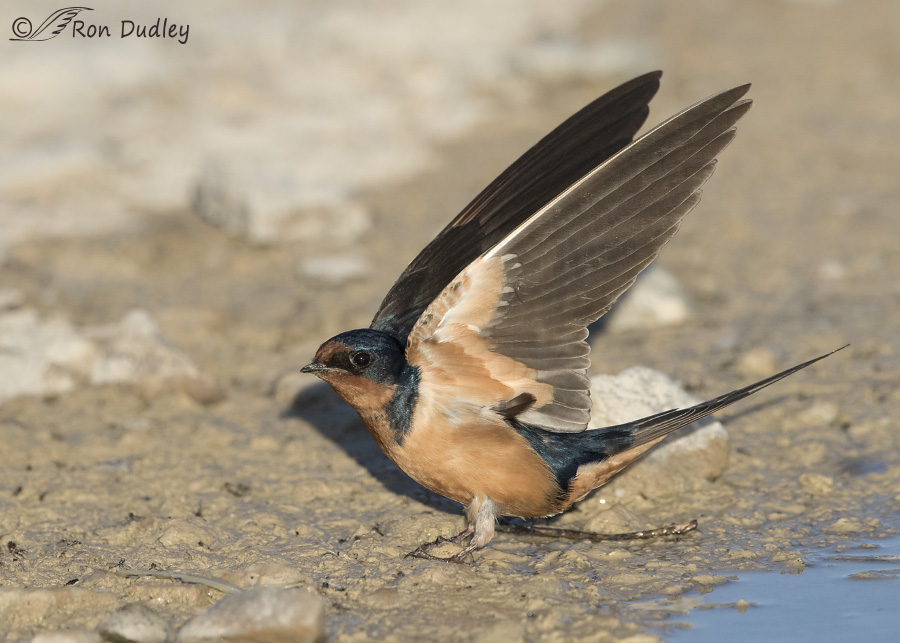
1/4000, f/6.3, ISO 800, Canon 7D Mark II, Canon EF 500mm f/4L IS II USM + 1.4 tc, not baited, set up or called in
Yesterday morning I spent some time with Barn Swallows on Antelope Island as they gathered mud from a puddle for the nests they were building. When they landed in the mud they would sometimes hold both wings up in a fairly dramatic pose. Notice that this bird has its feet wrapped around a pebble in an apparent attempt to avoid getting muddy feet?
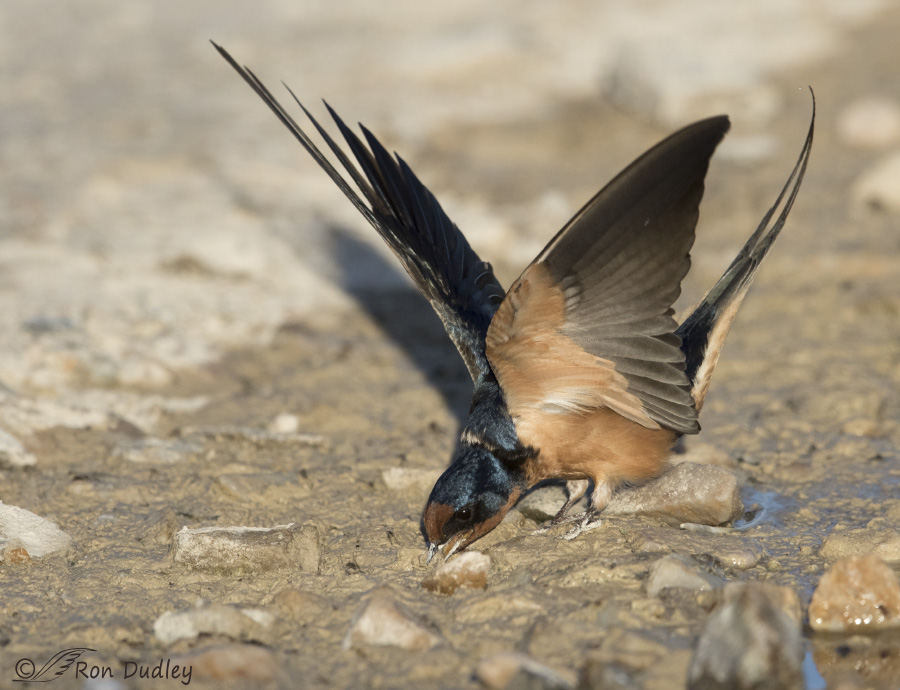
1/4000, f/6.3, ISO 800, Canon 7D Mark II, Canon EF 500mm f/4L IS II USM + 1.4 tc, not baited, set up or called in
They would often keep their wings up as they gathered mud.
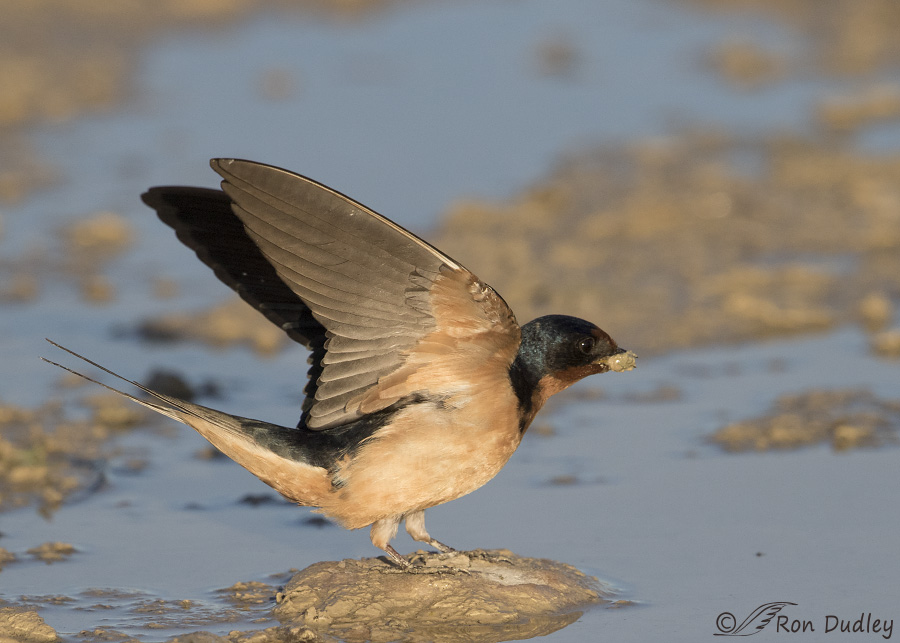
1/5000, f/6.3, ISO 800, Canon 7D Mark II, Canon EF 500mm f/4L IS II USM + 1.4 tc, not baited, set up or called in
At times they had much more mud in their bills than this but this swallow gave me a nice angle as it alighted on a small “island” in the puddle.
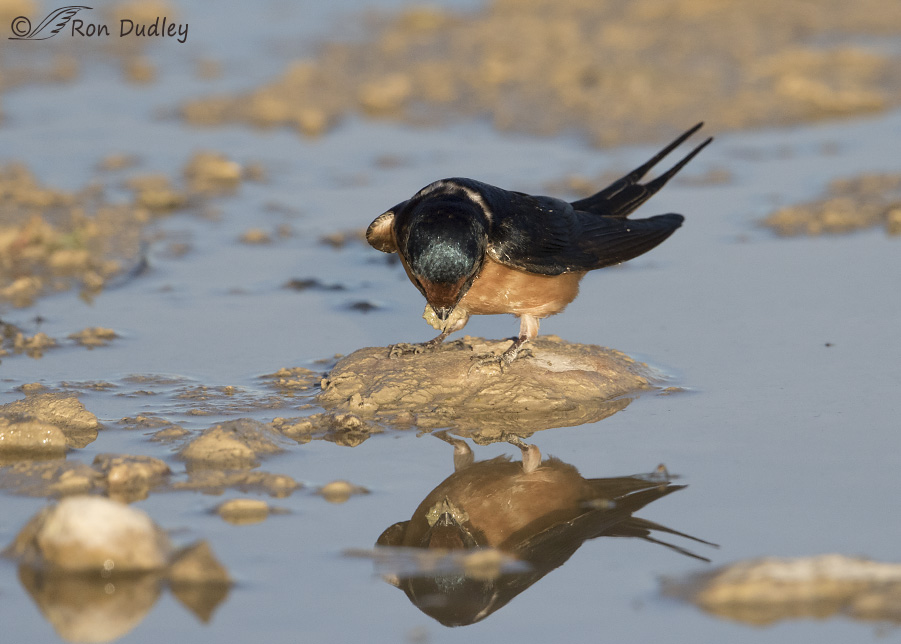
1/4000, f/6.3, ISO 800, Canon 7D Mark II, Canon EF 500mm f/4L IS II USM + 1.4 tc, not baited, set up or called in
Obviously, this bird was checking its own reflection to see if it had enough mud in its bill to make the flight to its nest worthwhile…
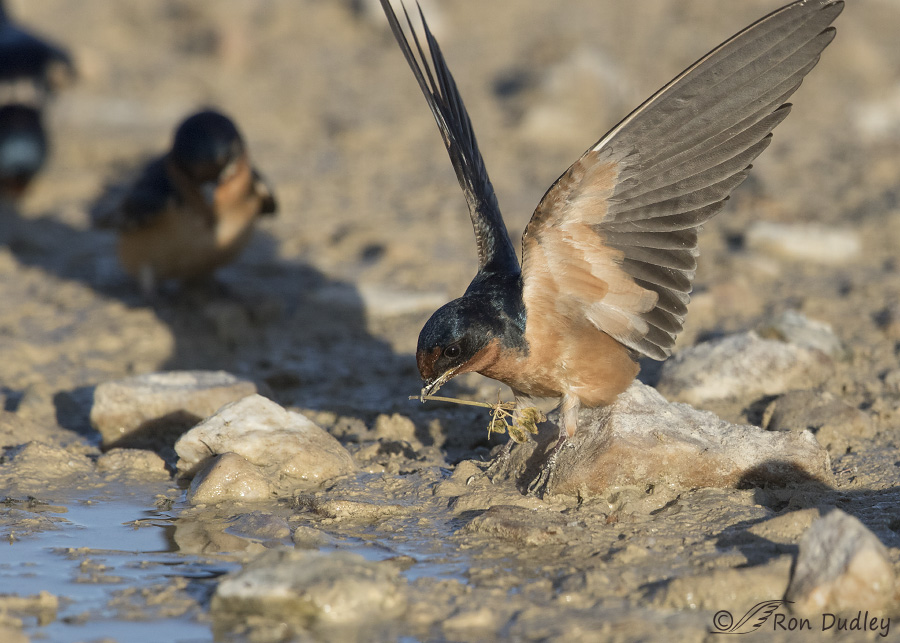
1/4000, f/6.3, ISO 800, Canon 7D Mark II, Canon EF 500mm f/4L IS II USM + 1.4 tc, not baited, set up or called in
These swallows were gathering more than just mud. They’d pick up different kinds of debris and mix it in with the mud before flying off with it. This bird has a small piece of vegetation.
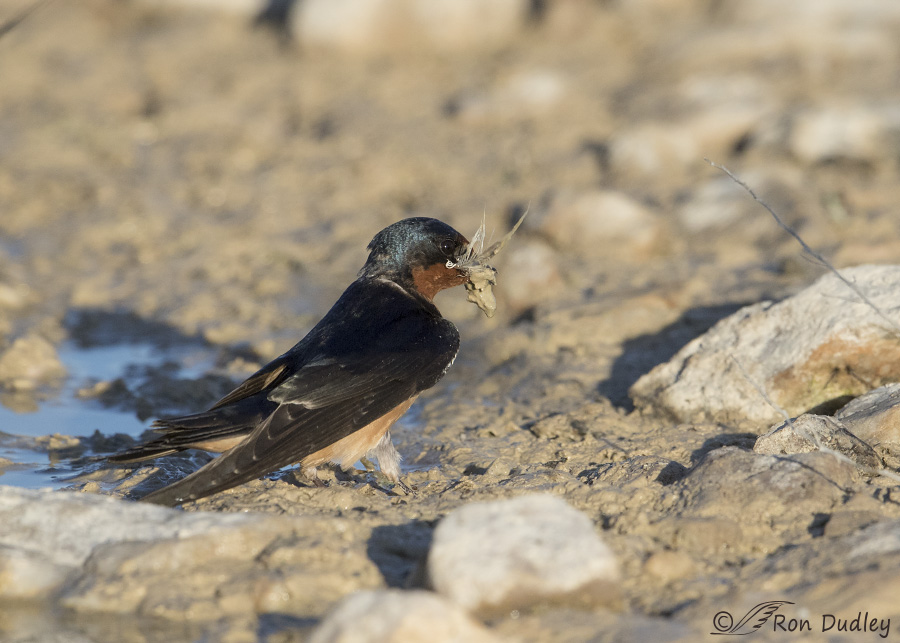
1/4000, f/6.3, ISO 800, Canon 7D Mark II, Canon EF 500mm f/4L IS II USM + 1.4 tc, not baited, set up or called in
And this one has a variety of debris in its bill – including a small feather (I know it was a feather from other images where it was more obvious). Many species of birds (gulls especially) bathe in this long-standing puddle and their activities leave many feathers behind.
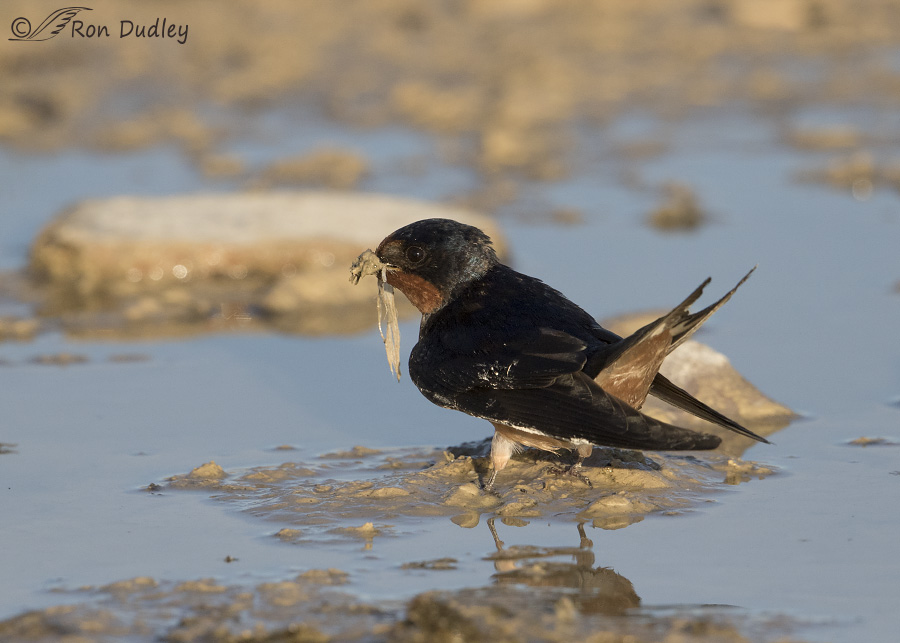
1/4000, f/6.3, ISO 800, Canon 7D Mark II, Canon EF 500mm f/4L IS II USM + 1.4 tc, not baited, set up or called in
This also appears to be a feather – whatever it is it’s obviously more than just mud.
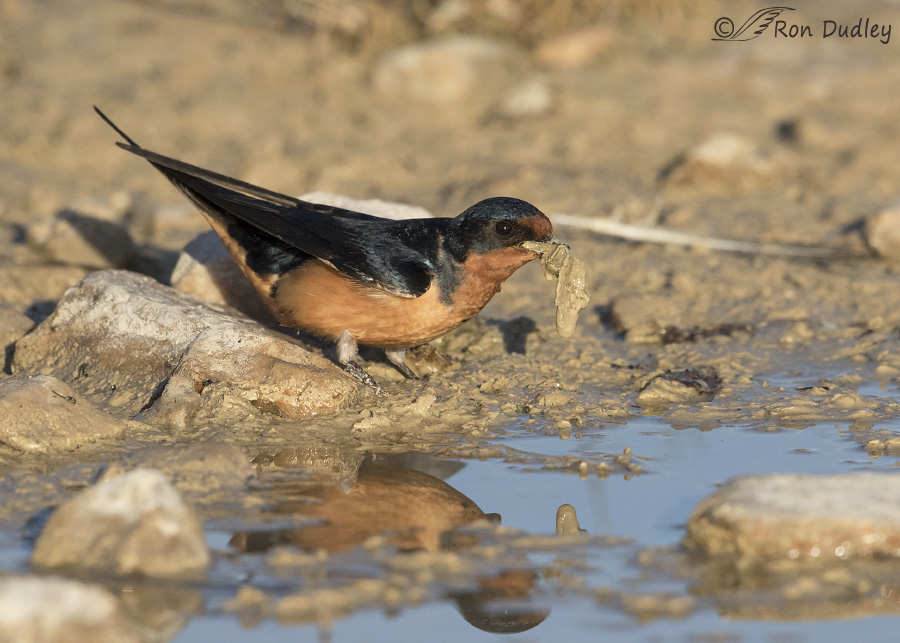
1/4000, f/6.3, ISO 800, Canon 7D Mark II, Canon EF 500mm f/4L IS II USM + 1.4 tc, not baited, set up or called in
Sometimes I couldn’t even guess what they had in their bill.
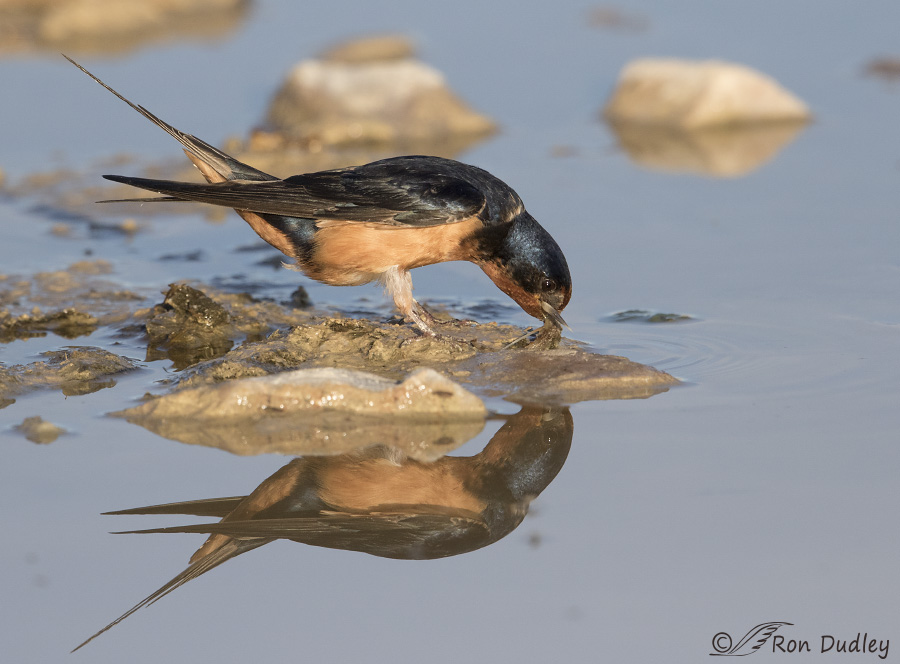
1/4000, f/6.3, ISO 800, Canon 7D Mark II, Canon EF 500mm f/4L IS II USM + 1.4 tc, not baited, set up or called in
They could see desirable things in the mud that I couldn’t and reach down to pick them up. Sometimes they discarded them…
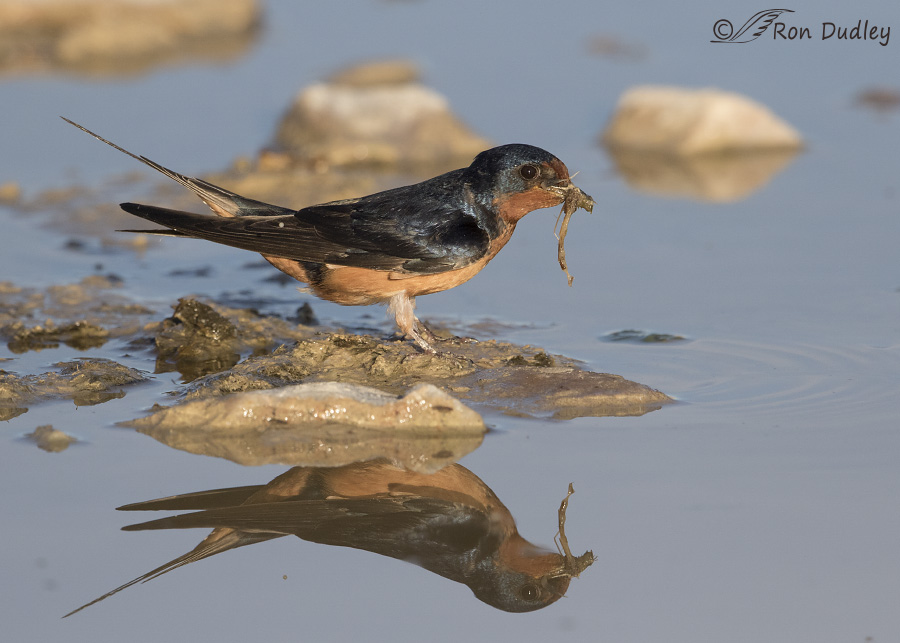
1/4000, f/6.3, ISO 800, Canon 7D Mark II, Canon EF 500mm f/4L IS II USM + 1.4 tc, not baited, set up or called in
but most often they’d mix them in with more mud before they flew off.
I’ve never noticed Barn Swallows gathering anything but mud in the past so as I watched these birds I came up with one of those half-baked theories that I’m (in)famous for. It goes something like this:
This mud near the shore of the Great Salt Lake is composed largely of a unique kind of sand called oolitic sand. Unlike typical sand composed of angular particles of silica, oolitic sand is composed of concentric layers of calcium carbonate that precipitate out of the lake water around a tiny brine shrimp dropping (usually). The resulting sand grains are egg-shaped (oolite means “egg stone”). There would be very little clay in this kind of “mud” to make it cohesive when it dried. A mixture of mostly oolitic sand and water would be unstable and crumbly after it dried.
So, as I was watching these swallows I began to wonder if they were deliberately including all these different kinds of organic debris in their construction for the same reason that humans incorporate straw or other organic materials in mud when they’re making adobe bricks – to make them stronger and last longer after they dry. Adobe buildings last many, many years when properly maintained.
A little research on Birds of North America Online at least partially confirmed my suspicions. According to BNA Barn Swallows often mix grass stems with the mud when constructing their nests (though they said nothing about other kinds of organic materials). And these mud Barn Swallow nests can last a surprisingly long time – some nests in Nebraska have lasted at least 17 years and eventually became greater than 27″ (70 cm) in depth after having more mud added annually. Pretty impressive!
So yes, I learned some things from these swallows, both directly and indirectly. And I thank them for it.
Ron



Gorgeous photos of a beautiful bird. A friend of mine here in Albuquerque has had BASWs nest in the corner of her stuccoed front porch for many years. A few years ago, I notice a new addition of mud which transformed the cup nest into the gourd-shaped enclosed nest of Cliff Swallows! Since then the Cliffs have been nesting! The mud is even applied differently, like some of the buildings in Chaco Canyon. Very interesting.
Beautiful photos as usual. Nice observations and detail story to the photos. I grew up in a stone and adobe house, those bricks are strong to most forces except rain.
Thank you Ron for the info you provide us everyday. This is great info about them. I have only seen them fly around and occasionally sit on a wire.
Thanks. I make it a point to visit your blog everyday.
I too find Barns Swallows interesting. I have seen them build underneath freeways here in Calif. I have such a hard time getting a picture of these fast birds. Good for you Ron!
Teach it Ron! I just soak it up and I am thankful that you do. I continue to appreciate your blog so much.
Ha, teaching’s obviously in my blood, Susan! Thanks for the encouragement.
I have always enjoyed Barn Swallows, and your images and comments increased my enjoyment! Thanks for sharing!
“I have always enjoyed Barn Swallows”
Me too, Jane, – too bad everyone doesn’t. I’ve known of folks in the past who destroyed their nests because they didn’t want them on their buildings. Those same people would also complain about all the mosquitoes around their homes and buildings. Go figure…
Thanks Ron for another great series. The largest cluster of mud swallow nests that I have ever seen (at least a several hundred) are pasted to river carved under-hang, and vertical volcanic wall of the South Menan Butte in Idaho. The Henry’s Fork and the South Fork of the Snake River meet at the east end of these to impressive coned buttes and then follows the southern edge of the south butte for about a mile. We always floated under these nests when fishing the river. I always wondered about those brave young swallows who’s first flight out of that small mud hole was directly over the water. They only had one chance to get it right.
An interesting comment, Marvin. I enjoyed it very much. Yes, that first flight would be a perilous one for those young swallows.
The work ethic and boundless energy of these swallows is something to behold. Thank you Ron for sharing these up close photos of the mud gathering. Your photography is something I look forward to viewing every day.
Thanks very much, Linda.
Fantastic images and article. Thank you for sharing
Thanks for enjoying them and saying so, Carlotta.
Consider this for a moment. Birds were here long before humans showed up. I’ve often thought that they taught us about music, but why not construction methods, too? Just a thought.
Swallows (and swifts) are amazing birds, just amazing. I love atching them zipping through the sky, often radiating their outrageous iridescence, glinting in the sunlight! And what a delight to see their construction methods up close and personal. Another thought I’ve often had is that they’re FAR more intelligent than we humans realize, just simply because we judge intelligence based on OUR realities, not theirs. It’s akin to judging the intelligence of a fish on its ability to climb a tree. I think we need to open our eyes, step outside of our humanity and quit looking at other species/languages/cultures through our anthrocentric priorities. OK, stepping off my soapbox now and kicking it under the table. But let me leave you with one of the cool quotes I’ve collected over the years.
“There is nothing in which the birds differ more from man than the way in which they can build and yet leave a landscape as it was before.” Robert Wilson Lynd
Enjoyed the quote, Laura, and boy, isn’t it the truth! Just yesterday I looked for a Western Kingbird nest where it was last year. Not a trace of it left…
Absolutely.
Birds, and other animals (except for our species) travel lightly across the land…
We have a great deal to learn, and birds is an excellent place to start.
I’ve never seen Barn Swallows build nests anywhere but in the barn and mostly outside under the overhang–under the eaves, of the barn. Where else do they build there nests?
It’s a complicated answer, Patty. This from BNA:
“Mud nest is either fastened to a vertical wall underneath a horizontal overhang, often near juncture of wall and ceiling, or built on top of a horizontal ledge or other substrate underneath an overhang. Nests are sometimes built on top of curled wires or rods. Reportedly uses cavities and crevices in rock faces, in which case typical mud nest is not built. In Mississippi, 20 nests were attached to flat, relatively smooth vertical walls; 28 nests to walls on a crack; 4 to masonry bolts protruding from a wall; 36 to mud nests of wasps (Trypoxylon politum) or mud daubers (Sceliphron caementarium) that were in turn attached to flat vertical walls; 9 to wasp nests in a corner between walls and beams; and 1 to a wasp nest in a crack on a corner (Jackson and Burchfield 1975). Solitary Barn Swallow nests were more likely to be attached to wasp nests than were Barn Swallow nests in colonies (Lohoefener 1980). In British Columbia, 46% of 2,537 nests were attached to rafters or beams of buildings, 18% under eaves, 11% on ledges or projections, 9% on vertical walls, and 5% over light fixtures.”
Thanks!! Very interesting info. Brings up another question I’ve often wondered about– why wasp nests are so often seen hanging over a road…not back into the woods, in fact. I’ve never seen them in the woods, but when I do see them, they are ways in a tall tree, on a high branch, at the edge of a road…often overhanging the road…makes me wonder about the elements of “choice”, “thought”, etc…..can it really just boil down to “instinct”??? Are we yet again underestimating another specie…like “we” have done with “people of color” and women, to name only two……
That was supposed to be first, FOURTH and last….but like them all, anyway….they always nested in our barn…my sisters and I raised one…we became very good at snatching flies out of the air…fortunayely, there were lots of targets….and, we difn’t jave to do it for too long (just seemed like it!)….
Great shots! Particularly like the first, third and last…you and Mia have me travelling down memory lane this morning…
I hope you enjoy the trip, Patty!
I joined Charlotte and Dick in wondering while I read, and then remembered a more primitive human building method, “wattle and daub”, which occurred all over
the northern hemisphere in places which didn’t enjoy the abundant sun that made adobe-building possible–wattle and daub is very close to what swallows
do, and I think people almost surely got the idea from bird-watching !
I remember wattle and daub too, Kris. Ancestral Puebloans (old name Anasazi) used to use that construction method. It was the early Spanish in NA who taught Native Americans to form their adobe into bricks.
Wonderful series. I’ve watched Cave Swallows going for mud at Hueco Tanks in prior years. Also the Barn Swallows have a nest just over the door of the headquarters building that has been there for several years. At least last year they had two broods there, and watching the ready-to-fledge babies was a lot of fun. Despite that large amount of traffic that passes under their nest, they seem to really like the location. They are currently sitting on a batch of eggs.
Susan, Barn Swallows nested prolifically on one of the old barns in Montana when I was growing up on the farm. Watching them was one of my early experiences that fostered my interest in birds.
Wow! That’s sensational Ron! I wonder if the American Indians who made adobe dwellings learned it from the Swallows? What awesome behavioral shots!
Charlotte
I wonder the same thing, Charlotte – especially after reading Dick Harlow’s comment below.
I’d bet dollars to donuts the native people did learn this from the birds…the stories, myths, legends and dances I’ve learned have told of so many such lessons. As keen observers with a strong sense of kinship with the natural world, it would almost be a “given”…The old time Lakota, Navajo and Mohawk I knew didn’t think they knew everything and considered other critters to be wise beings with much to learn from….even the coyote and spider, who they considered “tricksters”…
I wonder if it could be proven that man learned from Barn Swallows how to make adobe bricks. Haven’t Barn Swallows been around longer than man?
Very interesting stuff, great images and a good lesson.
Many thanks for sharing.
“I wonder if it could be proven that man learned from Barn Swallows how to make adobe bricks”
Interesting question, Dick. Barn Swallows are the most widely distributed and abundant swallow in the world so it certainly seems possible to me.
VERY interesting and beautiful shots, Ron. We see them from a distance here(a bridge they use near by), but have never put glass of any sorts on them. Imagine they want to keep their wings out of the muck if possible. They are welcome visitors as they keep the mosquitos down nicely.
“Imagine they want to keep their wings out of the muck if possible”
That may be it, Judy, but I also wondered if it was a threat display directed at other nearby swallows. They often fight viciously when gathering mud but I didn’t see any of that kind of tension yesterday morning. Perhaps this display (if that’s what it is) helps to prevent fighting…?